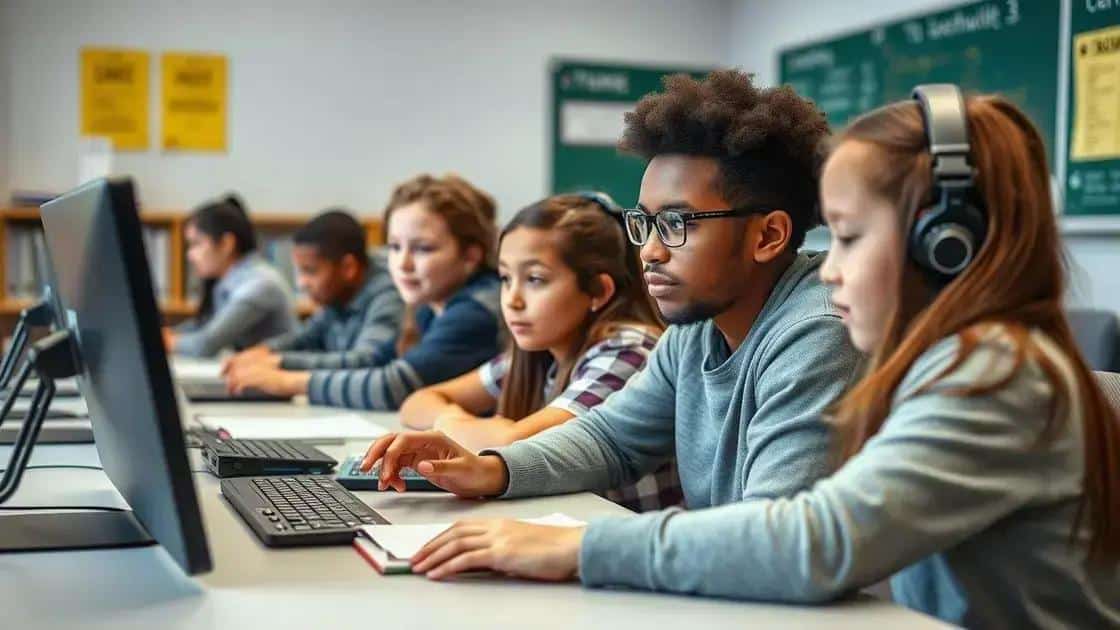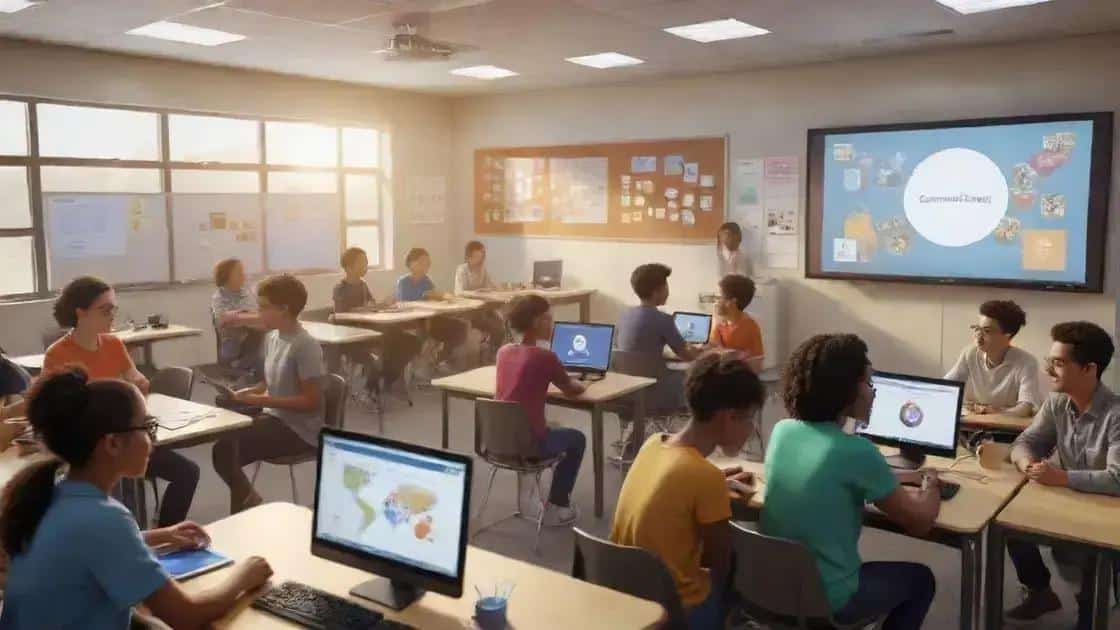Student results trends 2025: What to expect and why it matters

Strategies for educators to adapt to emerging trends include prioritizing professional development, effectively integrating technology, building strong relationships with students, and fostering a growth mindset to enhance the learning experience.
Understanding the student results trends 2025 is essential for educators and policymakers alike. What shifts can we expect in how students learn and achieve? Let’s dive into the emerging possibilities.
Key factors influencing student results in 2025
As we look ahead to 2025, there are several key factors influencing student results that educators need to focus on. Understanding these factors will help both teachers and students navigate the changing landscape of education effectively. One major factor is the rapid advancement of technology.
Technology’s Impact on Learning
Technology is transforming the classroom experience. With tools like tablets and online resources, students are gaining access to a wealth of information. This accessibility helps enhance their learning outcomes.
- Increased engagement through interactive learning tools.
- Personalized education plans using data analytics.
- Collaboration through virtual platforms.
Another important aspect is the role of teachers. As facilitators, they help integrate technology into lessons and promote critical thinking. Professional development for educators is crucial. Ongoing training ensures teachers are equipped with the latest strategies to support students.
The Influence of Family and Community
Family support also plays a significant role in student performance. When families are engaged in their children’s education, results improve. This support can manifest in various ways, such as:
- Attending school events and parent-teacher meetings.
- Encouraging reading and homework at home.
- Creating a positive study environment.
Furthermore, community involvement enhances student outcomes. Schools that partner with local organizations can offer additional resources and mentorship opportunities. These collaborations can motivate students and open doors for future success.
In addition, the changing nature of assessments is important to consider. Traditional tests may not accurately reflect a student’s abilities. By moving towards more comprehensive evaluation systems, we can better gauge student understanding and provide the necessary support for improvement.
Overall, the combination of technology, effective teaching, family support, and community involvement shapes the educational experience. Parents, teachers, and communities must work together to create an environment conducive to success as we move towards 2025.
The role of technology in shaping education outcomes
Technology plays a vital role in shaping education outcomes, especially as we move toward 2025. From interactive learning tools to accessible online resources, the impact of digital advancements is undeniable. One significant advantage is how technology can enhance student engagement and understanding.
Interactive Learning Tools
Using tools like educational apps and interactive whiteboards helps capture student attention. These resources make learning more enjoyable and promote active participation.
- Students can explore subjects in a hands-on manner.
- Real-time feedback allows for immediate adjustments in learning.
- Gamification motivates students by incorporating game-like elements.
Each of these features contributes to improved understanding and retention of information. Moreover, technology empowers personalized learning experiences. Online platforms can adapt lessons to fit individual student needs, catering to different learning styles.
Accessing Information
The vast amount of information available online is another aspect to consider. Students can access a wealth of resources at their fingertips. This accessibility encourages self-directed learning, where students can pursue their interests and deepen their knowledge.
- Students can engage with diverse perspectives through various media.
- Online libraries and databases offer extensive research materials.
- Collaboration tools enable sharing ideas with peers.
Additionally, technology facilitates communication between students and teachers. Virtual platforms make it easy for students to ask questions and get help outside the classroom. This connection fosters a supportive learning environment and encourages students to take charge of their education.
Overall, the integration of technology into the learning process enhances education outcomes. By leveraging these tools, educators can better meet the evolving needs of their students, paving the way for a more effective educational landscape in the future.
Comparative analysis of student achievements during the decade

A comparative analysis of student achievements over the past decade reveals substantial changes influenced by various factors. By examining trends, we can gain insights into how education has evolved and the implications for the future.
Shifts in Test Scores
Over the years, standardized test scores have seen significant fluctuations. Data suggests that, while some areas have shown improvement, others have struggled to keep pace. Factors contributing to these shifts include:
- Changes in curriculum standards.
- Socioeconomic impacts on learning environments.
- Technological advancements affecting teaching methods.
Notably, schools that have integrated technology into their teaching strategies often report higher student performance. This highlights the importance of adapting to modern educational tools to meet students’ needs.
Demographic Variations
Another aspect to consider is how different demographic groups have performed. When we look closely, we can see disparities among various backgrounds. These disparities can often be attributed to:
- Access to resources and support systems.
- Parental involvement in education.
- Cultural attitudes towards education.
Understanding these factors helps identify areas that require focus to promote equity in education. Addressing these variations ensures that all students have the opportunity to succeed.
Additionally, exploring achievement gaps between urban and rural areas shows that location can greatly affect educational outcomes. Students in urban settings may have more access to advanced course offerings and extracurricular activities than those in rural schools.
Overall, a thorough comparative analysis of student achievements from the last decade not only highlights progress but also showcases areas where improvements are needed. Keeping an eye on these trends enables educators and policymakers to create strategies that foster academic success for all.
Predictions for educational policy changes
Predictions for educational policy changes in the coming years are crucial as we adapt to new challenges and opportunities. As technology continues to shape the classroom, policies must evolve to support innovative teaching methods and diverse student needs.
Emphasis on Equity
One of the most significant areas of focus is equity in education. Future policies are likely to prioritize:
- Reducing resource disparities among schools.
- Implementing inclusive practices that cater to diverse learning needs.
- Expanding access to advanced coursework, especially in underserved communities.
These changes will help bridge the gap for students who may lack the same opportunities as their peers. Additionally, there will be a push for community engagement to ensure stakeholder voices are heard in decision-making.
Integration of Technology
Another key area for policy development will be the integration of technology in education. As digital tools become a staple in classrooms, policies will need to address:
- Training teachers to effectively use technology in their lessons.
- Establishing guidelines for online learning environments.
- Ensuring data privacy and security for students.
This emphasis on technology will also require financial investments in infrastructure, particularly for schools in low-income areas. By enhancing access to technology, we can create a more equitable learning landscape.
Moreover, policies may shift towards more flexible learning environments. This could mean more options for online education and hybrid learning models that cater to the needs of modern students.
As we look to the future, it’s clear that educational policies must adapt to the changing landscape. With a focus on equity and technology, we can ensure that all students have the tools and opportunities necessary to succeed.
Strategies for educators to adapt to emerging trends
As educational trends continue to evolve, it is essential for educators to adopt effective strategies to stay relevant and support their students’ needs. Understanding and adapting to these emerging trends can greatly enhance the learning experience.
Embrace Professional Development
One key strategy for educators is to prioritize professional development. This can involve:
- Participating in workshops and training on new technologies.
- Collaborating with peers to share best practices.
- Staying updated with the latest educational research and methodologies.
By investing in their own growth, teachers can better equip themselves to navigate changing classroom dynamics and implement innovative teaching techniques.
Incorporate Technology Wisely
Another important approach is to integrate technology thoughtfully into the curriculum. This means:
- Using educational software that aligns with learning goals.
- Encouraging students to engage with digital tools and resources.
- Ensuring that technology enhances, rather than replaces, traditional learning methods.
Technology should serve as a tool for enhancing student engagement and understanding, not as a distraction from meaningful learning. Creating a balanced environment enables students to benefit from the best of both worlds.
In addition, cultivating a growth mindset among students encourages them to embrace challenges and learn from mistakes. This approach fosters resilience, which is crucial for adapting to a rapidly changing educational landscape.
Furthermore, building strong relationships with students creates a supportive atmosphere. Understanding their unique learning styles and needs allows educators to tailor their instruction accordingly. This individualized approach can lead to better student outcomes.
Overall, by embracing continuous learning, leveraging technology, and fostering strong student relationships, educators can successfully adapt to emerging trends and create a more dynamic learning experience for all.
FAQ – Frequently Asked Questions about Educators Adapting to Emerging Trends
What are the benefits of professional development for teachers?
Professional development helps teachers stay updated on best practices and enhances their teaching skills, ultimately benefiting student learning.
How can technology be integrated effectively in the classroom?
Technology can be integrated by using tools that enhance engagement, allowing students to interact with lessons and receive instant feedback.
Why is it important to build relationships with students?
Building relationships fosters a supportive learning environment, encourages student participation, and helps educators understand individual needs.
What is a growth mindset, and why does it matter in education?
A growth mindset encourages students to view challenges as opportunities to learn, which can lead to increased resilience and academic success.






